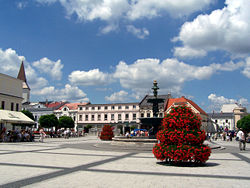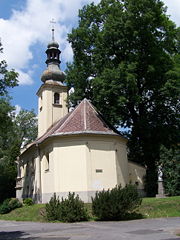
Fryštát
Encyclopedia

Moravian-Silesian Region
Moravian-Silesian Region , or Moravo-Silesian Region, is one of 14 administrative Regions of the Czech Republic, until May 2001 it was formerly called the Ostrava Region . The region is located in the north-eastern part of its historical region of Moravia and in most of the Czech part of the...
of the Czech Republic
Czech Republic
The Czech Republic is a landlocked country in Central Europe. The country is bordered by Poland to the northeast, Slovakia to the east, Austria to the south, and Germany to the west and northwest....
, now administratively a part of the city of Karviná
Karviná
Karviná is a city in Moravian-Silesian Region of the Czech Republic, on the Olza River. It is administrative center of Karviná District. Karviná lies in the historical region of Cieszyn Silesia and is one of the most important coal mining centers in the Czech Republic. Together with neighboring...
. Until 1948 it was a separate town. It lies on the Olza River
Olza River
is a river in Poland and the Czech Republic, the right tributary of the Oder River. It flows from the Silesian Beskids through southern Cieszyn Silesia in Poland and Frýdek-Místek and Karviná districts of the Czech Republic, often forming the border with Poland. It flows into the Oder River north...
, in the historical region of Cieszyn Silesia
Cieszyn Silesia
Cieszyn Silesia or Těšín Silesia or Teschen Silesia is a historical region in south-eastern Silesia, centered around the towns of Cieszyn and Český Těšín and bisected by the Olza River. Since 1920 it has been divided between Poland and Czechoslovakia, and later the Czech Republic...
.
History

Cieszyn Silesia
Cieszyn Silesia or Těšín Silesia or Teschen Silesia is a historical region in south-eastern Silesia, centered around the towns of Cieszyn and Český Těšín and bisected by the Olza River. Since 1920 it has been divided between Poland and Czechoslovakia, and later the Czech Republic...
. Development of the town was set back by a major fire in 1511 when all of the wooden houses burnt down. Fish farming
Fish farming
Fish farming is the principal form of aquaculture, while other methods may fall under mariculture. Fish farming involves raising fish commercially in tanks or enclosures, usually for food. A facility that releases young fish into the wild for recreational fishing or to supplement a species'...
became an important industry for the town with the creation of several ponds in the 16th century. The 17th century had a mostly negative impact on the town's development with fires, epidemics and the Thirty Years' War
Thirty Years' War
The Thirty Years' War was fought primarily in what is now Germany, and at various points involved most countries in Europe. It was one of the most destructive conflicts in European history....
. In 1623 about 1,400 citizens died of bubonic plague
Bubonic plague
Plague is a deadly infectious disease that is caused by the enterobacteria Yersinia pestis, named after the French-Swiss bacteriologist Alexandre Yersin. Primarily carried by rodents and spread to humans via fleas, the disease is notorious throughout history, due to the unrivaled scale of death...
. The town was occupied for nearly thirty years by Danish forces and then by Swedish forces. The dilapidated town was then bought by owners of nearby Karwin, the Larisch-Mönnich family. They built a château
Château
A château is a manor house or residence of the lord of the manor or a country house of nobility or gentry, with or without fortifications, originally—and still most frequently—in French-speaking regions...
there and raised the town from poverty, but a fire in 1823, Prussian occupation in 1866 and epidemics again made the development of the town difficult. Coal was discovered in 1776, but it was not until 1794 that it began to be exploited on a large scale. As a result of the coal industry, rapid development of the town and surrounding villages occurred. Its impact was both positive and negative. Old settlements were destroyed and landscape was devastated. Industrial and coal mining expansion as well as the construction of railroads led to rapid growth of the area's importance. It became the most industrialized area in Austria and later Czechoslovakia. In 1850 Freistadt became a district although nearby Karwin with many coal mines and industrial facilities was more populous.
According to the Austrian
Austria-Hungary
Austria-Hungary , more formally known as the Kingdoms and Lands Represented in the Imperial Council and the Lands of the Holy Hungarian Crown of Saint Stephen, was a constitutional monarchic union between the crowns of the Austrian Empire and the Kingdom of Hungary in...
census of 1910 the town had 5,058 inhabitants, 4,835 of whom had permanent residence there. The census asked people for their native language, 2,878 (59.5%) were Polish-speaking, 1,704 (35.2%) were German-speaking and 253 (5.2%) were Czech-speaking. Jews
Jews
The Jews , also known as the Jewish people, are a nation and ethnoreligious group originating in the Israelites or Hebrews of the Ancient Near East. The Jewish ethnicity, nationality, and religion are strongly interrelated, as Judaism is the traditional faith of the Jewish nation...
were not allowed to declare Yiddish
Yiddish language
Yiddish is a High German language of Ashkenazi Jewish origin, spoken throughout the world. It developed as a fusion of German dialects with Hebrew, Aramaic, Slavic languages and traces of Romance languages...
, most of them thus declared the German language as their native. The most populous religious groups were Roman Catholics with 4,437 (87.7%) followed by the Jews
Jews
The Jews , also known as the Jewish people, are a nation and ethnoreligious group originating in the Israelites or Hebrews of the Ancient Near East. The Jewish ethnicity, nationality, and religion are strongly interrelated, as Judaism is the traditional faith of the Jewish nation...
with 341 (6.7%) and Protestants with 267 (5.3%).
After the division of Cieszyn Silesia in 1920 it became a part of Czechoslovakia
Czechoslovakia
Czechoslovakia or Czecho-Slovakia was a sovereign state in Central Europe which existed from October 1918, when it declared its independence from the Austro-Hungarian Empire, until 1992...
as the main mining center of the country. In October 1938, together with the whole region known as Zaolzie
Zaolzie
Zaolzie is the Polish name for an area now in the Czech Republic which was disputed between interwar Poland and Czechoslovakia. The name means "lands beyond the Olza River"; it is also called Śląsk zaolziański, meaning "trans-Olza Silesia". Equivalent terms in other languages include Zaolší in...
, it was annexed by Poland
Poland
Poland , officially the Republic of Poland , is a country in Central Europe bordered by Germany to the west; the Czech Republic and Slovakia to the south; Ukraine, Belarus and Lithuania to the east; and the Baltic Sea and Kaliningrad Oblast, a Russian exclave, to the north...
, and during World War II
World War II
World War II, or the Second World War , was a global conflict lasting from 1939 to 1945, involving most of the world's nations—including all of the great powers—eventually forming two opposing military alliances: the Allies and the Axis...
was a part of Nazi Germany
Nazi Germany
Nazi Germany , also known as the Third Reich , but officially called German Reich from 1933 to 1943 and Greater German Reich from 26 June 1943 onward, is the name commonly used to refer to the state of Germany from 1933 to 1945, when it was a totalitarian dictatorship ruled by...
. After the war it again became part of Czechoslovakia. In 1948 it was merged with Karviná and became a part of that city. In 1960 reform of administrative divisions was made and Fryštát District ceased to exist. It was superseded by newly created Karviná District
Karviná District
Karviná District is a district within the Moravian-Silesian Region of the Czech Republic. Its administrative center is the city of Karviná. It was created by 1960 reform of administrative divisions in the area of former Fryštát District...
. Fryštát forms the historical center of Karviná, which is otherwise an industrial city.
People
- Alfred BiolekAlfred BiolekAlfred Biolek is a well-known German entertainer and television producer...
- German television producer - Henryk FlameHenryk FlameHenryk Antoni Flame was a corporal and pilot in the Polish Air Force, and a captain of the anti-Nazi, and anti-Communist resistance organization NSZ.-Early life:Henryk was the son of Emeryk and Maria...
- Polish World War II pilot - Dana ZátopkováDana ZátopkováDana Zátopková was a Czech javelin thrower. She won the gold medal for javelin in the 1952 Summer Olympics , and the silver medal in the 1960 Summer Olympics. She was the European champion in 1954 and 1958...
- Czech athlete

